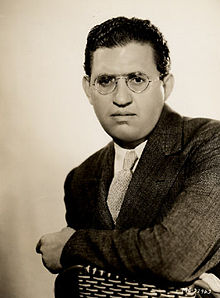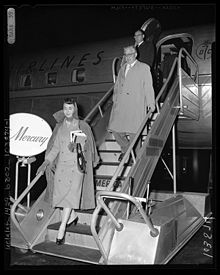- David O. Selznick
-
David O. Selznick 
Born May 10, 1902
Pittsburgh, PennsylvaniaDied June 22, 1965 (aged 63)
Hollywood, CaliforniaSpouse Irene Mayer Selznick (1930–1948)
Jennifer Jones (1949–1965)David O. Selznick (May 10, 1902 – June 22, 1965) was an American film producer. He is best known for producing Gone with the Wind (1939) and Rebecca (1940), both of which earned him an Oscar for Best Picture.
Contents
Early years
Born David Selznick to a Jewish family in Pittsburgh, Pennsylvania, he was the son of silent movie distributor Lewis J. Selznick and Florence A. (Sachs) Selznick. Selznick added the "O" to his name later on a whim.[1]
He studied at Columbia University and worked as an apprentice for his father until the elder's bankruptcy in 1923. In 1926, Selznick moved to Hollywood, and with the help of his father's connections, got a job as an assistant story editor at Metro-Goldwyn-Mayer. He left MGM for Paramount Pictures in 1928, where he worked until 1931, when he joined RKO as Head of Production.
His years at RKO were fruitful, and he worked on many films, including A Bill of Divorcement (1932), What Price Hollywood? (1932), Rockabye (1932), Our Betters (1933), and King Kong (1933). While at RKO, he also gave George Cukor his directing break. In 1933 he returned to MGM to establish a second prestige production unit, parallel to that of Irving Thalberg, who was in poor health. His unit's output included Dinner at Eight (1933), David Copperfield (1935), Anna Karenina (1935) and A Tale of Two Cities (1935).
Selznick International Pictures
Despite his successes at MGM, Paramount Pictures, and RKO Pictures, Selznick longed to be an independent producer with his own studio. In 1935 he realized that goal by forming Selznick International Pictures and distributing his films through United Artists. His successes continued with classics such as The Garden of Allah (1936), The Prisoner of Zenda (1937), A Star Is Born (1937), Nothing Sacred (1937), The Adventures of Tom Sawyer (1938), The Young in Heart (1938), Made for Each Other (1939), Intermezzo (1939) and Gone with the Wind (1939), which remains the highest grossing film of all time (adjusted for inflation). It also won seven additional Oscars and two special awards. Selznick also won the Irving G. Thalberg Memorial Award that same year.
In 1940, he produced his second Best Picture Oscar winner in a row, Rebecca, the first Hollywood production for British director Alfred Hitchcock. Selznick had brought Hitchcock over from England, launching the director's American career. Rebecca was Hitchcock's only film to win Best Picture.
Later productions
After Rebecca, Selznick closed Selznick International Pictures and took some time off. His business activities included the loan of his contracted artists to other studios, including Alfred Hitchcock, Ingrid Bergman, Vivien Leigh and Joan Fontaine. He also developed film projects and sold the packages to other producers. Among the movies that he developed but then sold were almost all of Hitchcock's films through to 1947, except for two that he released through Selznick International Pictures or Selznick Releasing Organization, Spellbound and The Paradine Case. In 1944 he returned to producing pictures with the huge success Since You Went Away, which he wrote. He followed that with Spellbound (1945), as well as Portrait of Jennie (1948), a vehicle for Jennifer Jones. In 1949, he co-produced the Carol Reed picture The Third Man with Alexander Korda.
Gone with the Wind overshadowed the rest of Selznick's career. The closest he came to matching it was with Duel in the Sun (1946) featuring future wife Jennifer Jones in the role of the primary character Pearl. With a huge budget, the film is known for causing moral upheaval because of the then risqué script written by Selznick. And though it was a troublesome shoot with a number of directors, the film would turn out to be a major success. The film was the second highest grossing film of 1947 and turned out to be the first movie that Martin Scorsese would see, inspiring Scorsese's director's career.
"I stopped making films in 1948 because I was tired", Selznick later wrote. "I had been producing, at the time, for twenty years . . . . Additionally it was crystal clear that the motion-picture business was in for a terrible beating from television and other new forms of entertainment, and I thought it a good time to take stock and to study objectively the obviously changing public tastes . . . . Certainly I had no intention of staying away from production for nine years."[2] Selznick spent most of the 1950s nurturing the career of his second wife, Jennifer Jones. His last film, the big budget production A Farewell to Arms (1957) starring Jones and Rock Hudson, was ill received. But in 1954, he ventured into television, producing a two hour extravaganza called Light's Diamond Jubilee, which, in true Selznick fashion, made TV history by being telecast simultaneously on all four TV networks: CBS, NBC, ABC, and DuMont.
Personal life
Selznick married Irene Gladys Mayer, daughter of MGM mogul Louis B. Mayer, in 1930. They separated in 1945 and divorced in 1948.[3] They had two sons, Daniel and Jeffrey Selznick. In 1949 he married actress Jennifer Jones and they had one daughter, Mary Jennifer Selznick (1954–1976), who committed suicide by jumping from a 20th-floor window in Los Angeles on May 11, 1976.
Death
Selznick died in 1965 following several heart attacks, and was interred in the Forest Lawn Memorial Park Cemetery in Glendale, California. Until his death in 1944, Myron Selznick, Selznick's brother, was one of the most powerful agents in Hollywood.
For his contribution to the motion picture industry, David O. Selznick has a star on the Hollywood Walk of Fame at 7000 Hollywood Blvd., in front of the historic Hollywood Roosevelt hotel.
Film library
After Selznick's death, his estate sold the rights to a majority of his post-1935 films to ABC's syndication subsidiary ABC Films. Due to fin-syn rules in the 1970s, ABC Films was spun-off and renamed Worldvision Enterprises in 1973. Worldvision was purchased by Taft in 1979 and sold to Aaron Spelling in 1988. In 1994, Worldvision was incorporated into Republic Pictures and Spelling sold to Viacom. MGM bought in 1944 the rights to Gone with the Wind and, at some point, the 1937 version of The Prisoner of Zenda for its 1952 remake (all today part of the Turner Entertainment library owned by Time Warner), and 20th Century Fox still holds rights to the remake of A Farewell to Arms. As for the ABC-owned Selznick films, distribution is now the responsibility of Walt Disney Studios Motion Pictures (Disney Enterprises currently owns ABC).
Academy Awards and nominations
Year Award Result Film 1934 Outstanding Production Nominated Viva Villa! 1935 Outstanding Production Nominated David Copperfield 1936 Outstanding Production Nominated A Tale of Two Cities 1937 Outstanding Production Nominated A Star Is Born 1939 Outstanding Production Won Gone with the Wind 1938 Irving G. Thalberg Memorial Award Nominated 1939 Irving G. Thalberg Memorial Award Won 1940 Outstanding Production Won Rebecca 1944 Best Motion Picture Nominated Since You Went Away 1945 Best Motion Picture Nominated Spellbound Filmography
See also
References
- Thomson, David. Showman: The Life of David O. Selznick. New York: Knopf, 1992. ISBN 0-394-56833-8
Further reading
- Selznick, David O. (2000 reprint) [original publication 1972 by Viking Press]. Behlmer, Rudy. ed. Memo from David O. Selznick. New York: Modern Library. ISBN 0-375-75531-4. (Free preview at Amazon.com)
External links
- David O. Selznick at the Internet Movie Database
- David O. Selznick at AllRovi
- David O. Selznick at the TCM Movie Database
- "David O. Selznick". Find a Grave. http://www.findagrave.com/cgi-bin/fg.cgi?page=gr&GRid=941. Retrieved August 28, 2010.
Categories:- American film producers
- American screenwriters
- American film studio executives
- Film studio executives
- Columbia University alumni
- People from Pittsburgh, Pennsylvania
- 1902 births
- 1965 deaths
- American Jews
- Deaths from myocardial infarction
Wikimedia Foundation. 2010.

